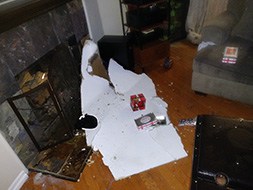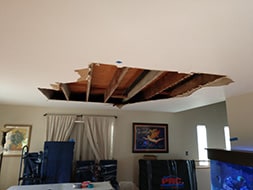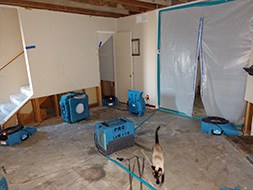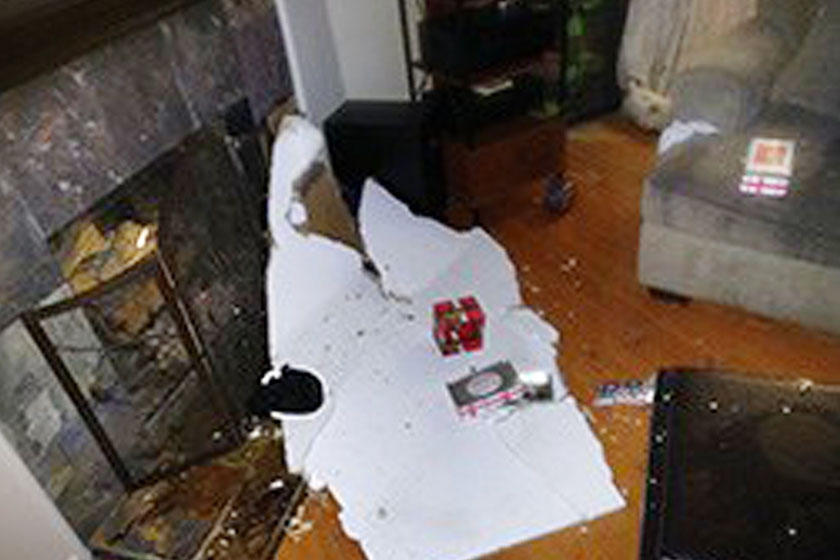I recently had a personal experience this holiday season involving asbestos that became a learning opportunity.
On the evening of December 30th, my wife Lorraine and I were in our warm, comfy home enjoying the holidays. We sat in our living room watching TV, having dinner with a nice glass of wine. There were a few wrapped Christmas presents still on the hearth, waiting for some of the kids who were out of town. We were chatting about the prime rib dinner I would be making for the family on New Year’s Day (they love my cooking!).

Suddenly and without warning, the drywall ceiling collapsed on our heads, followed by a deluge of water, scattering our dinner and breaking dishes. We were both soaked, along with the couch and floor. Slabs of drywall littered the living room, as water continued to flow from the ceiling. After the initial shock, I turned to Lorraine, laughed, and said, “WTF!” (not the abbreviated version). It was like something out of a movie or TV show. What a mess!
We soon determined that our washing machine malfunctioned and had emptied all of its wash cycle water onto our second-floor laundry area, which then came through the first-floor ceiling. We contacted a disaster restoration company, and they immediately sent over some folks to start the clean-up and dry down, with dehumidifiers, fans, etc.
Obviously, with 22 years in the mold business, I know a thing or two about dry downs. Typically, when you start the dry down process, you want to remove baseboards right away, and even put some small holes in the walls to aid drying. Getting those baseboards off is very important, because the baseboards and the sill plate inside the wall (that’s the 2 x 4 wood framing at the bottom of walls) creates a sandwich that can trap moisture. If you don’t get those baseboards off, there’s a real good chance that the wall will stay wet long enough to grow mold. It only takes 3 to 5 days for mold growth to start. However, when I asked the workers if they were going to take my baseboards off, they told me they could not do any demolition until we had an asbestos test performed. I was told that this was the law, and that they were not going to violate it.

This was really surprising because “common knowledge” has been that you shouldn’t need to test for asbestos for buildings constructed after 1985 (my insurance agent later told me they will not reimburse for testing buildings built after 1988). So, being both surprised, and a bit annoyed, I decided to do some research. In fact, Rule 1403 of the South Coast Air Quality Management District (“SCAQMD”) – who enforces air pollution regulations in Los Angeles, Orange, San Bernardino and Riverside Counties – indeed requires that asbestos testing be done regardless of a property’s age, whenever renovation or demolition is to be performed.
Coincidently, the following week, I attended a Lead Inspector recertification class in which there was also a lot of discussion about asbestos. The class instructor – who also teaches asbestos certification classes – confirmed that there is no age exemption for asbestos testing. He even handed out a copy of a letter from the Federal EPA that said the same.
Now, this seems pretty excessive to me, as I am sure it does to many of you. However, one of the students in the lead class mentioned that a property he had recently worked on – which was built in 2013 – had asbestos in the drywall joint compound. The fact remains that although heavily regulated, asbestos is not banned in the U.S. Few manufacturers here still use it, due to the potential for civil liability and the heavy amount of workplace regulations; but there are still foreign products (most notably from China) that do contain asbestos. These products can include drywall, joint compound, tape, any type of resilient flooring, and many roofing materials. This is the EPA’s rationale for testing, regardless of the age of the structure.

The law states that any remodeling project, no matter how small (there are no size exemptions), must have asbestos testing if it potentially disturbs building materials that could contain asbestos. This obviously includes remodeling, repairs, and, of course, dry down and mold remediation projects. Even homeowners doing the work themselves are supposed to test prior to starting work. There are some exemptions to allow single-family homeowners (i.e., not apartments, duplexes, or condos, etc.) to remove asbestos themselves, but these exemptions have several criteria. If you are going to engage in a do-it-yourself project that could involve asbestos, go read the law first. (However, is it really worth the risk? I recommend that testing get done, and if found, you do not deal with asbestos yourself. Call a qualified contractor!). Bottom line: Contractors (and, in many cases, homeowners) that are not checking for asbestos prior to starting remodeling or renovation projects are violating the law.
This law can create some very frustrating situations. For example, those with properties in escrow, or, as in my case, the added time now required for asbestos testing during a dry down project. My flood, having happened on a Saturday night, didn’t get tested until Monday. Tuesday was New Year’s Day, which meant the analytical lab was closed. So, we lost at least two days due to the testing requirement. As expected, testing results came back negative for asbestos.
Fortunately, the delay did not result in any mold growth, as the disaster restoration team did a good job drying things down. We did end up removing most of the living room wall bottoms just to be safe, along with most of the ceiling and hardwood floor. The rebuilding has been completed and a new couch is on order. I had a chat with the insurance adjuster about the law and the need to test; the adjuster said she would discuss it with her management. I am not holding my breath for a “thank you” from them. Oh, and that fantastic prime rib dinner I was going to make? The prime rib never made it out of the freezer.
If you want to read more on this topic, check out the SCAQMD’s FAQ sheet on Rule 1403 here.






